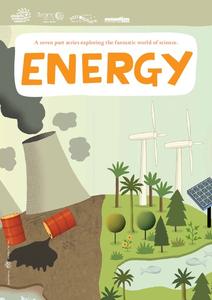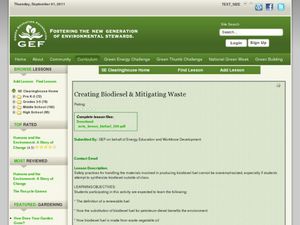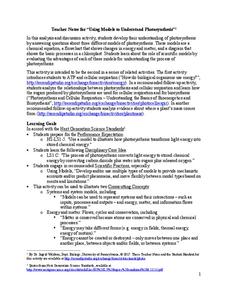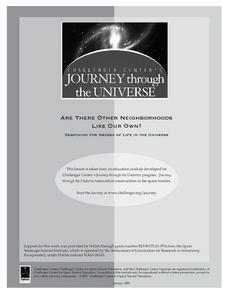Curated OER
Energy and Change: The Five Basic Laws
Five basic law of physics and energy are listed here, with a simple explanation of what each actually means in the real world! Your young physicists will appreciate the concepts being made more relevant and the language being made more...
University of Waikato
Māui and the Sun
Using a Maori legend, How Maui Tamed the Sun, youngsters are introduced to the importance of sunlight to civilization. Teach them about nuclear fusion that occurs to produce the solar energy we later receive on Earth as...
Curated OER
Chemiluminescence
Students explore chemiluminescence through various experiments. In this chemistry lesson plan, students explain the chemical reaction that drives the process. They give real life applications of chemiluminescence.
Curated OER
Simple Organic Compounds
In this organic compounds activity, students read about the development of chlorofluorocarbons and the breakdown of this compound in the atmosphere. Students complete 2 short answer questions.
Curated OER
Black Hole Power...X
In this power of black holes activity, students solve 6 problems including finding the surface area of a black hole, determining the amount of matter in the black hole shell, finding the rest mass energy and determining the time it takes...
Curated OER
What is the Nucleus Like?
In this nucleus of an atom worksheet, students answer 19 multiple choice questions about the structure of the atom, radioactive decay, isotopes and half life.
Smith Family Home
Transportation
Here's an interesting lesson plan that combines elements of language arts, sociology, and a study of the many ways that people use transportation to get from one place to another. The eight-page plan includes worksheets and a word search...
Curated OER
Energy
In this science worksheet, students learn about renewable, non-renewable and sustainable energy and examine alternative fuel sources by studying the information on these 8 pages. Students complete 20 questions about energy. These pages...
California Academy of Science
Color Vision Genetics Evolution Simulation
At one point, all mammals carried only two color receptors, but now most humans carry three. An informative presentation and hands-on activity demonstrate how this evolved through genetics. By participating in the activity, pupils...
Curated OER
X-ray Spectroscopy and the Chemistry of Supernova Remnants
This link takes you to a comprehensive unit that delves into emission spectra and supernovas. There are four parts: How and where elements are created, electromagnetic radiation, spectroscopy, and the newest technology for studying our...
Curated OER
Cold War Era Film Censorship: High Noon- a Slice of Americana Or Communist
Students study of the effects of the Cold War on the home front. They analyze the film High Noon according to an abbreviated version of the standards that films were judged by in the early 1950s and determine whether or not High Noon is...
Curated OER
It's Greek To Me!
In this language activity, scholars use Greek root meanings to determine the meaning of words. After being shown how Greek roots are used in many words, such as, photosynthesis, pairs are given two excellent black line masters...
Curated OER
Kinds of Sentences
Help your students mix up their writing with different kinds of sentences with this PowerPoint. Each slide gives a brief definition of the various types including: declarative, interrogative, imperative, and more! There are also examples...
Curated OER
Character Tea Party
A tea party in Wonderland? An East Egg brunch with Gatsby, Daisy, Tom, and Nick? Breakfast with Miss Havisham, Lady Macbeth, and Abigail Williams? Or dinner with Andre, Hamlet, and Randle Patrick McMurphy? Class members select a favorite...
Curated OER
Creating Biodiesel and Mitigating Waste
Biotechnology pros produce their own biofuel using waste oil and fresh vegetable oil. They test the quality of their product using titration techniques and pH analysis. They write their observations and report their findings. Be aware...
Serendip
Using Models to Understand Photosynthesis
Is your class in the dark about photosynthesis? Shed some sunlight on an important biological process with a thoughtful activity. After answering questions to help determine their level of knowledge, learners work with chemical equations...
Curated OER
Circle of Pong
Learners, in groups, use given materials to devise a way to deposit a ping-pong ball into a paper cup that is located in the middle of a 6-foot diameter circle, while standing outside the circle.
Curated OER
Design a Bobsled
Young scholars apply their knowledge of friction, drag, mass and gravity as they design, build, and test mini-bobsleds.
Curated OER
Sending Messages to Space
Students interpret a message sent to space using a radio telescope and draw inferences from the interpreted message. Working with a partner, they interpret data that scientists believe is a message from aliens. They work on organizing...
Curated OER
Harvesting Mosaics
Students use pieces of farm pictures to investigate the elements of art. In this farm art lesson, students use pieces of pictures to create an original artwork. Students use the Internet to find images. Students create a...
Texas State Energy Conservation Office
Investigation: Making a PV Cell
Rise and shine! Class members collaborate to construct a photovoltaic solar cell with two semiconductor layers, as guided by this fabulous lab sheet. They test its output with an ammeter or galvanometer.
Incredible Art
Micrography Self-Portraits
Words. Words. Words. Class members create micrography self-portraits combining a high contrast portrait photo with words that express themselves. Complete directions for the project, student samples, along with links to professional...
Virginia Department of Education
Properties of Compounds and Chemical Formulas
Young chemists have unknown compounds they need to sort. Performing three different tests on each, the chemical behaviors they observe become the basis for data analysis.
Curated OER
Science Puzzlers, Twisters, and Teasers: Chemical Bonding
What a cute approach to chemical bonding! Atoms all have human names and are attending at a dance. Who will pair up with whom? By reading the characteristics, and not the element name, chemistry whizzes figure out the bonding pairs....























